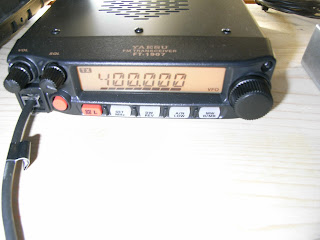Fixing the Palstar AT-Auto
I have owned an AT-AUTO since they were first released and its given good service. One area that it let me down was 10M.
On 28Mhz the coil can sometimes go into self resonance so tuning isn't possible. I fixed this by temporarily shorting the last four turns of the coil with some thin coax brain. It was an easy fix as the braid just slides between the coils and no soldering is required.
The problem with this solution is that I then lost the ability to tune on 160M :(
Working on 10M is more important for me as there is no (or very little ) RTTY on Top band. But I really wanted both!
I recently bought an MFJ 962 tuner for field day operation which includes a neat little feature built into the coil to damp self oscillation. This is an elegant fix and kudos to MFJ for solving the problem!
That got me thinking, and I designed a little device for the Palstar.
My solution is basically a folded piece of .3mm copper sheet that attaches to the opposite side of the coil support and is lifted by the tuning wheel as it travels down the coil.
on 10M the resonance damper sits on the coil. I used a pair of mini cable ties both sides to keep it in position (If it slid too far back it would foul the stop which sits proud of the coil end)
I soldered a sort piece of braid to the copper sheet which runs to the earth bar, this ensures the copper is earthed. Fold the edge of the sheet up where the tuning wheel runs. It will then lift the plate from the coil as it reaches the lower end (160M) tuning
So far it worked fine and I get tuning down to 160M with no self resonance on 28 or 29 Mhz!
Its early days but if it seems to work reliably. I may tidy this up and do an engineering drawing. To be honest it's very simple,
A picture paints a thousand words so here is the solution.
If you own an AT-AUTO why not give it a go. It's inexpensive, and the Palstar AT-AUTO is an awesome piece of kit.!
Now I look at the coil I may buy a replacement?
On 28Mhz the coil can sometimes go into self resonance so tuning isn't possible. I fixed this by temporarily shorting the last four turns of the coil with some thin coax brain. It was an easy fix as the braid just slides between the coils and no soldering is required.
The problem with this solution is that I then lost the ability to tune on 160M :(
Working on 10M is more important for me as there is no (or very little ) RTTY on Top band. But I really wanted both!
I recently bought an MFJ 962 tuner for field day operation which includes a neat little feature built into the coil to damp self oscillation. This is an elegant fix and kudos to MFJ for solving the problem!
That got me thinking, and I designed a little device for the Palstar.
My solution is basically a folded piece of .3mm copper sheet that attaches to the opposite side of the coil support and is lifted by the tuning wheel as it travels down the coil.
on 10M the resonance damper sits on the coil. I used a pair of mini cable ties both sides to keep it in position (If it slid too far back it would foul the stop which sits proud of the coil end)
I soldered a sort piece of braid to the copper sheet which runs to the earth bar, this ensures the copper is earthed. Fold the edge of the sheet up where the tuning wheel runs. It will then lift the plate from the coil as it reaches the lower end (160M) tuning
So far it worked fine and I get tuning down to 160M with no self resonance on 28 or 29 Mhz!
Its early days but if it seems to work reliably. I may tidy this up and do an engineering drawing. To be honest it's very simple,
A picture paints a thousand words so here is the solution.
If you own an AT-AUTO why not give it a go. It's inexpensive, and the Palstar AT-AUTO is an awesome piece of kit.!
Now I look at the coil I may buy a replacement?





















